Is there Authorship, Authenticity and Authority in Multi-Natural Design?
Synopsis:
A fictional conversation following a congregation of a particular and peculier bunch of personalities at Sagrada Familia before its inauguration.
Original version of this conversation with its intended layout could be found here:
https://readymag.com/u3953292578/4069301/
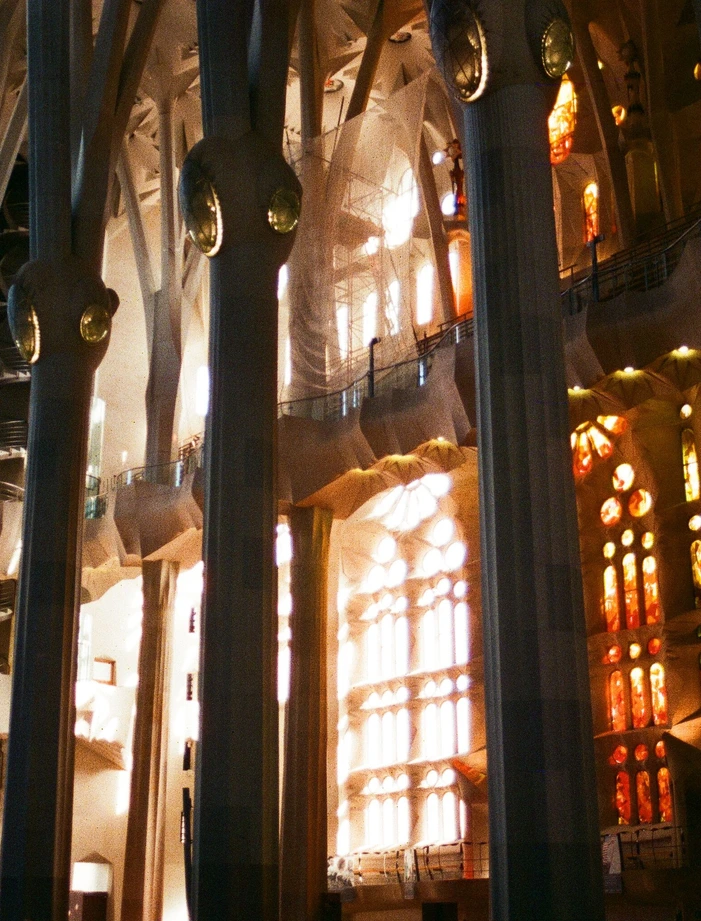
https://www.over-onpartystudio.com/film-photography
ACT-1:
The ethereal sun’s rays pass through the charming brand new windows of the now finished Sagrada Familia, whose last screw was turned the previous evening. The lights are channelled on top of the Cardinal’s phone screen, gushing into his face and giving him a heavenly aura.
*sounds of a slight murmur*
ICOMOS: I’m driving. I can’t read your text your Eminence, could you please send me an audio?
The cardinal approaches the screen of his phone several times, hopelessly trusting that all those keys and lights will give him an answer.
CARDINAL: An audio? And how should I do it? Hmmm..
*Beep*
Dear President, Good Mor-
*Beep*
Hello! I’m your Google operator, where do you want to go-
Oh dear, delete! Delete! Back! What happened? I’m sure it was the right button! Let me try again..
*Beep*
“Dear President, Good Morning! Here is your Eminence the Cardinal of the Sagrada Familia. I am extremely elated in announcing that last night the work was finally completed. The Basilica is officially ready to be shown to the public in its entirety! The last formality is to complete its recognition as a World Heritage Asset.”
*Beep. A few moments later*
ICOMOS: Your Eminence, I am still waiting for your message. I thought you wanted to tell me something about the Basilica, didn’t you?
*The cardinal listen again to the ICOSMOS’ President audio, scrolling the tiny screen of his old phone. “The message was not delivered.*
CARDINAL: Good Grief! I heard some tourists complaining about the poor reception here..
Amazing how these walls are so thick and imposing not to let even the internet frequencies pass!
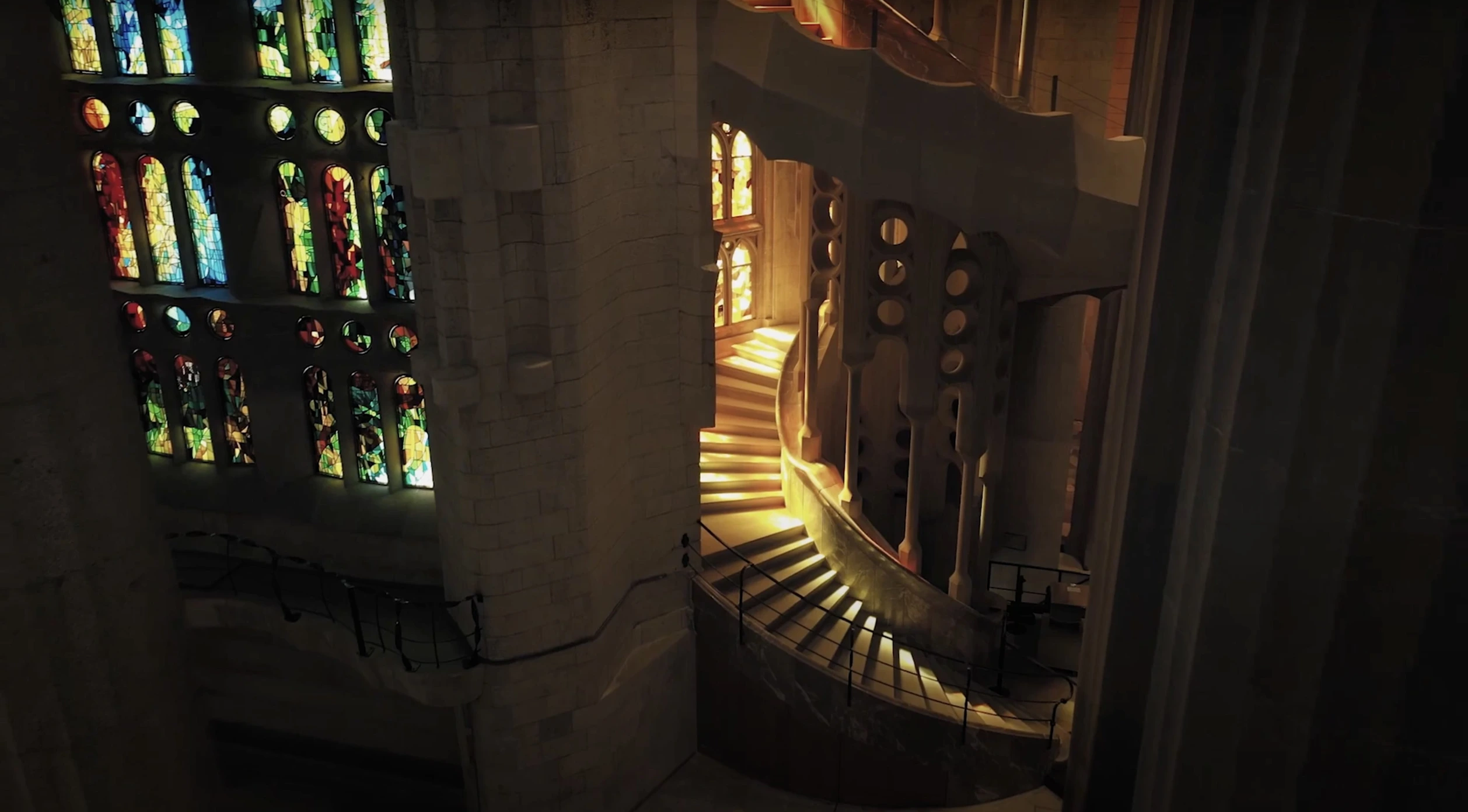
https://www.youtube.com/watch?v=Z3GJrJMhIW4
ACT-2:
The sun lashes against the head of tourists and Catalans in Placa de Gaudì, being forced to wait for the outcome of the visit of the experts. Today, precisely 100 years after the departure of the great Gaudi, is finally the day when the inauguration is celebrated, waiting just for the last parts of the Monument to be recognized worthy of the World Heritage Title.
For this more unique than rare occasion, the ICOMOS’s President and expert team members are here gathered, walking silently between the classrooms of the church, visually examining every minute detail. The Cardinal, who for this day wore his favorite choral cassock, is happier than ever, following them diligently.
ICOMOS: It is our greatest pleasure to be here for such an important occasion. I believe I can speak on the behalf of everyone by stating how astonished we all are at the sight of the aforesaid majestic Monument.
*Noises of evident nervousness are heard from the Cardinal, who continues to tap the floor with his foot while waiting for the outcome*
We have meticulously analysed each of the parts submitted for the general review, and it is our honour to announce that almost all of them have been accepted…
CARDINAL: Excuse me, Madam? I certainly misunderstood what you just said, the age I find myself having, doesn’t play in my favour and my hearing is getting worse.
I thought I just heard you declining to recognize the Sagrada as an entirety.
*sounds of throat clearing*
ICOMOS: Excuse me, His Eminence Cardinal, but this is an official procedure, and I would appreciate your cooperation by letting me finish my statement.
*he interrupts her again*
CARDINAL: What an amusing story to tell to my cherished members of the Foundation’s Board of Trustees! We all know this is just a formality, who can indeed afford to judge this Masterpiece, that by the end of today will acquire the title of World Heritage?
*ICOMOS President continues her speech as if she had not heard the words of the cardinal*

https://sagradafamilia.org/en/history-of-the-temple
ICOMOS: In declaring the greatness of the Sagrada we would like to spend a few words for a special thanks to all those who made it possible:
…to Francesc de Paula Quintana, who in 1939 took over the site management.
…to Isidre Puig i Boada and Lluís Bonet i Garí who took the place of their predecessor in 1966 .
…Surely to mention Francesc Cardoner i Blanch… of course Jordi Bonet i Ameringo .. And at last special thanks goes to Jordi Faulì, who couldn’t unfortunately be here with us tonight.1
(Sagrada Familia website https://sagradafamilia.org/en/history-of-the-temple)
CARDINAL:Young lady, please excuse me, I understand that your youth might be the cause of your lack of awareness of worldly things. Each of the fancy names you just mentioned has something in common, which is the opportunity to work under the creative genius of Gaudì and his will. It is so evident that this masterpiece has a single creator.
“To preconceive and to determine in the mind and with judgement something that will be perfect and complete in its every part is the achievement of the true architect“ 2 (Alberti, L.B. (c. 1452). De re aedificatoria (On the art of building). In Rykwert, J., R. Tavernor & N. Leach (Trans. and Eds.) (1988). On the art of building in ten books. Cambridge, MA and London: MIT Press.)
ICOMOS: I abhor to inform His Eminence Cardinal that your standpoint is quite old fashioned.
“Sole authorship is more an exception than a rule in architecture. The involvement of a variable number of partners, collaborators, specialists, and even clients attests to the inadequacy of narratives extolling a grand master builder’s single authorship.“3 (CfP: Who Designs Architecture? On Silenced and Superimposed Authorship. RA, Revista de Arquitectura 23 https://eahn.org/2020/09/cfp-who-designs-architecture-on-silenced-and-superimposed-authorship-ra-revista-de-arquitectura-23/)
As has just been attested, this statement is more than targeted in describing the centenary history of the Basilica.
CARDINAL: Have I arrived at this fine age to hear loads of absurdity? Did you just compare that workforce to the Great Genius of Gaudì?
ICOMOS: His Eminence, I plead you to be reasonable and recognize the theoretical mistake you are committing-
CARDINAL: Theoretical mistake? Young lady, Objectively speaking the Sagrada is one of the greatest piece of art fallen in this sinful earth, and “all arts were born autographic handmade by their authors”4
(M. Carpo, The Alphabet of the Algorithm, 2011, p. 16)
ICOMOS: Your point looks alluring, but it lacks of conceptual palpability.
“Some arts became allographic: scripted by their authors in order to be materially executed by others“4
((M. Carpo, The Alphabet of the Algorithm, 2011, p. 16)
CARDINAL: Looks like you know how to use rhetoric but not how to support your reasoning so that it’s unconquerable.
Though, “the lifespan of major building programs may be longer than that of any architect, and that many incidents may occur during the construction to alter or pervert the original design“.5
Yet, “the author’s original intentions” should always be upheld”.
(M. Carpo, The Alphabet of the Algorithm, 2011, p. 22)
ICOMOS: Something very subtle is slipping away from you:
“The only work truly made by the architect is the design of the building, not the building itself, which by definition is made by others”.5
(M. Carpo, The Alphabet of the Algorithm, 2011, p. 22)
CARDINAL: Fortunately my Dear Alberti can not hear these comments of yours, he’ll be spinning in his grave right now..
ICOMOS: His Eminence, I will patiently repeat this for the last time: it is not possible for us to erase the work of those who dedicated their whole lives to complete the Basilica.
*The ICOMOS’s President stealthily get closer*
Confidentially, keep it between us Father, but we are all aware that Gaudì’s drawings were burned down in that far 1936..How can we even consider this as his work anymore?
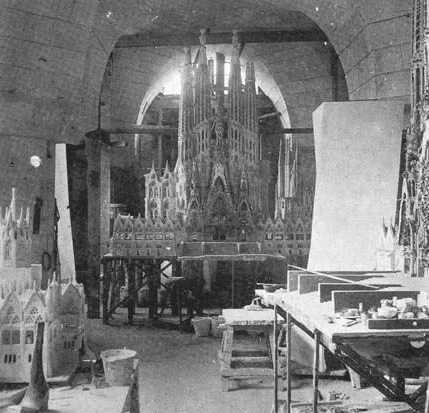
*The two of them, so close to perceive the rigidity of their thoughts clash ephemerally, feel that they were being observed: it is a curious character, that until a few moments before was reading some strange book on the Death of a certain God…*
JACINT: Oh, my apologies for the unexpected interruption, I was trying to read undisturbed but after hearing your discussion becoming more and more interesting, I could not help but come to examine in person!
CARDINAL: Examine what? And who might you be? How dare you barge in! We’re still in a church, have some consideration!
JACINT: With all due respect, but what church is it, if there is no God to reassure you?
CARDINAL: What havoc is he saying before me?!
*The Cardinal turn breathlessly to the ICOMOS’ President, looking for any sign of compassion that seems to be translated into a peck of sympathy*
JACINT: Apparently God is dead, as is your beloved architect as well. Both physically and morally,without a shadow of a doubt.
CARDINAL: Forgive me, young man, but we don’t have time for this kind of frivolity, we already have a lot to discuss!
JACINT: Of course, you can also continue with your chirp since you can’t even distinguish between authorship and value. Let me explain:“the intention of the author is neither available nor desirable as a standard for judging the success of a work of art.”6
(The intentional fallacy, W. K. Wimsatt and Monroe Beardsley, 1962[1946], p.92)
*sounds in the distance of resolute and fast steps are heard pressing the corridor*
TOA: HALT!
CARDINAL:Oh my God, who is it now?
JACINT: I already told you he doesn’t exist.
CARDINAL: Who are you talking about??
JACINT: Of your so-called God.
CARDINAL: SERIOUSLY? Young man, I think I’ve heard enough-
TOA: We heard you murmuring in the distance, you know this Basilica has fantastic acoustics, not for nothing we completed it just a few days ago. Ah ah ah!
CARDINAL: Since you all are here, I would like to clarify this misunderstanding once for all.
“it is generally known that Gaudí used design to create images inorder to depict a variety of religious ideas“.7 “Sagrada Familia, was conceived as nothing short of a Bible in stone.”7.
This, my gentlemens, tells a lot about the great history of this Basilica!
(E. Cline, The Lasting Relationship between Antonio Gaudí and Barcelona, 2022, p. 23)
TOA: Your Eminence you seem to have found it rather convenient to pass the individuality of us architects. Our status is that of authors, exactly like the one who first started the work.
*Coo Coo – sounds clearly coming from a bird are heard approaching at a fast pace*
JACINT: His Eminence, do you have any pets indoors here?
CARDINAL: Pets? I would never dare to tarnish the safety of this great Monument!
*Coo Coo! Coo Coo!*
JACINT: Oh, look there Cardinal, looks like you have a sign from the heavens, ah ah ah!
CARDINAL: Well.. That’s.. Ladies, and Gentlemen, that’s a dove! How could such a teeny animal come here, it’s clearly a sign from the above, Mr. Catalan finally you said something truth!
JACINT: Oh..well.. That was ironic, but anyway..
CARDINAL: You all, this is the Lord’s way to clear up your mind, reminding you that this Basilica was gloriously made by the only and great Gaudì! If you were looking for an answer my beloved President, here it is-
*Poop – the bird release itself on the Cardinal’s shoulder*
JACINT: …What a blessing!!
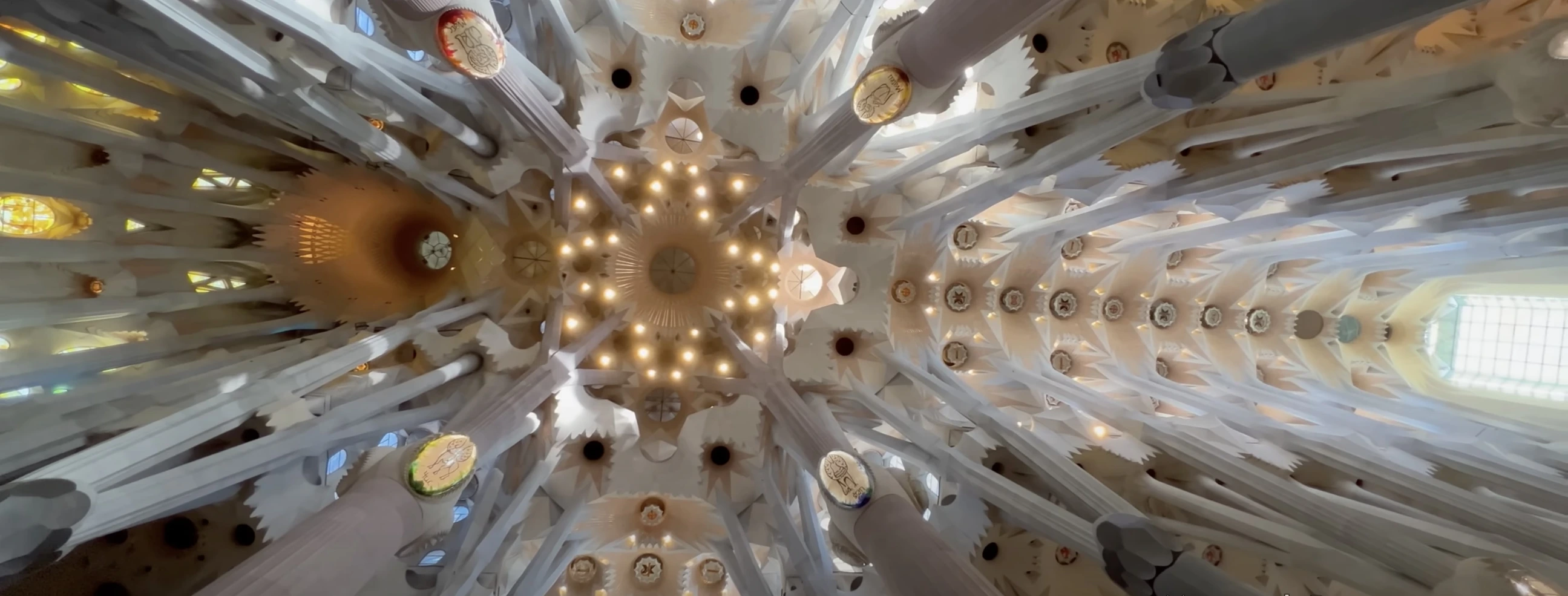
https://www.youtube.com/watch?v=Z3GJrJMhIW4
ACT-3:
The Team of the architects are now roaming in the nearby corridors of the Cathedral. They are here for a very clear reason: confirming that their hard work will be fairly appreciated. Another dear friend and colleague of them is going to be joining soon.
JACINT: I understand your need to place a name or names next to the building, but in my opinion
“Assigning an Architect to a building is to impose a brake on it, to furnish it with a final signified, to close its design“8
(Barthes R., The death of the Author, p. 6)
TOA: I object! Unfortunately we need to assign an architect,
“We need to ask why the Architect produce this kind of building and not another one, understanding the reasons and constraints behind his choices.“9
(Compagno D.,, Theories of Authorship and Intention in the Twentieth Century: An Overview, 2012, p. 48)
JACINT: I see your point.
“The image of architecture in the contemporary culture is tyranically centered on the Architect, on his person, his history, his tastes, his passion… The explanation of the work is always sought in the man who has produced it, it was always finally the voice of one and the same person, the architect, which delivered his “confidence” withing its works.“10
(Barthes R., The death of the Author, p. 2)
TECH: Oh what a pure and strictly theoretical argument! I agree, our image is considerably overboard, but what can we do about it if we are this great? The techniques we know and manage on a daily base allow us to think and forge on a new dimension.
TOA: Long time no see Techie! Still spending most of your time with your amazing scripts?
CARDINAL: Script? What is that? And who should this person be? I have never seen him in the Cathedral in these last months.
TECH: Last months? Your Eminence, I have worked here since the last 20 years. I suspect you have never noticed me because I’m someone whose work is done under the table.
The script, constitute the base of the parametric design we used while understanding Gaudì’s language.
CARDINAL: Parametric.. That’s such an intimidating word! It’s the first time I hear someone have the temerity to compare his work with the one of the Great Master Gaudì!
TECH: Parametric is “The use of algorithms in design and architecture: with this tool one day we will be able to delegate to computers the creation of all details of an entire city!“11
(Manovich L, A.I Aesthetics, p. 22)
CARDINAL: My hunch is suggesting me that this is something I don’t want to know more about.. How can you even mention to use this process? And how could these script things relate with the Sagrada?
TECH: Your Eminence, I think it’s safe to say that the advancements of Sagrada Familia would’ve been incomplete without the use of technology! “The Sagrada Família, originally inhabiting the misty space between Gaudí’s mind and the real world, continues to operate in multiple realities, only now it is stretched between the physical and digital worlds, especially thanks to these new parametrical inputs.“
TOA: That is precisely what I was about to say as well. Your eminence, the fact that the Temple of the Sagrada Família was a pioneer in introducing CAM into architecture is a little-known historical fact… This close collaboration between technology and architecture is what allowed us to finally complete the basilica.12
(Homar C. I., Serralonga A., The Sagrada Família, a pioneer in applying manufacturing robots to architectures, blog.sagradafamilia.org)
*The Cardinal sighs in dismission as he blatantly disagrees Cardinal is in aghast!*
TECH: Indeed, many modern thinkers and artists have
“envisioned a future where humans, liberated by machines from mechanical and boring work, will be engaging only in play and art and that“13
(Manovich L, A.I Aesthetics, p. 22)
CARDINAL: Gentlement, I beg for your understanding but
“if this so-called automation of cultural production by AI continues, eventually it will be these AI playing and making art… not us“13
(Manovich L, A.I Aesthetics, p. 22)
TECH: But your Eminence, this point of view of yours is very limitating: I wonder,
“Does AI integration in cultural production and reception lead to a decrease in aesthetic variability? Or does it, on the contrary, increase it?“14
(Manovich L, A.I Aesthetics, p. 35)
“We can only talk about fully AI-driven culture where AI will be allowed to create the finished design and media from beginning to end. In this future, humans will not be deciding if these products should be shown to audiences; they will just trust that AI systems know best“15
(Manovich L, A.I Aesthetics, pp. 16-17)
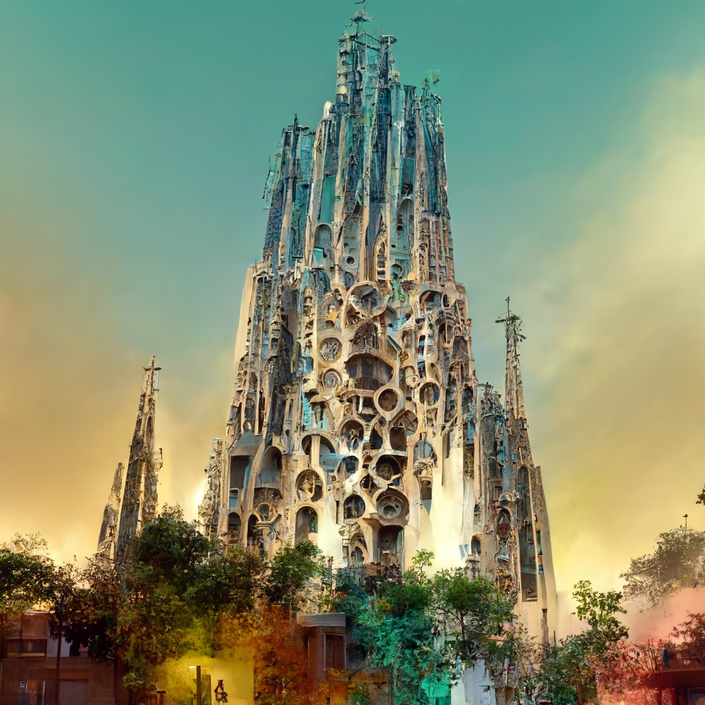
TOA: Hey, how about we slow down a little?
When we believe in an AI driven world, will we be able to prevent such an AI-metropolis from imposing on, regulating, and rationalizing our existence in the name of progress and human happiness?
CARDINAL: Prevent? The dark revolution of technology taking over has already begun! You have managed to adulterate the beauty of Gaudi’s breathtaking visions reducing it to nothing but a few clicks of a button! Pfftt…
JACINT: Your eminence, I suggest you take a few steps back: it’s not about one taking over the other, it’s all about symbiosis!
“it is easy to imagine a future scenario where cameras will themselves choose what and when to capture to give us the most satisfying photos that fit certain concepts and aesthetic ideals.“16
(Manovich L, A.I Aesthetics, p. 14)
TOA: Absolutely! The potential of this could be magnificent!
CARDINAL: Potential??? Rubbish! If all creative pursuits fall under the domain of AI, what will be the purpose of human existence, other than being swallowed whole by the monstrosity of these technological advancements?
TECH: Your Eminence, you said yourself that this Cathedral is Majestic, is it right?
CARDINAL: For God’s sake, why are you asking whimsical questions? Of course!
TECH: Being able to model the building better goes hand in hand with completing it faster: the work that once required skilled artisans months to finish can now be completed with the click of a mouse with the help of advanced digital fabrication technologies.
CARDINAL: Well, your so called technology helped you to understand the bright mind of an ingenious, who would have been otherwise unappreciated!
TECH: This is the meaning of SYMBIOSIS your eminence! To take the design envisioned by Gaudi and translate it through digital interventions! Similar to Gaia, the mother earth!
“If Gaudí was alive today, he would have brought 3D technology to its maximum exponent, since much of his work was already conceived tri-dimensionally,“17
(Architect, 3d printing helps century old project to finally complete, middleeastarchitect.com)
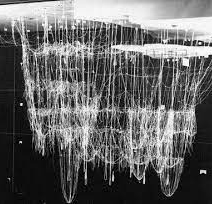
JACINT: Aaaaah, I see what you mean! But if you claim that this is the same as for Gaia, you should also say that there are actually no authors, since everything was made and is constantly existing in an “all-together” state.18
(M. Lynch, The Symbioti Planet, 2001, pp. 12-13)
TOA: “An architect’s name is not simply an element of speech!” We are all the authors!19
(Foucault M., What is an Author)
TECH: We abode in a symbiotic world. Gaia was made in symbiosis with all other organisms that populate it.
CARDINAL: Outrageous! Are you saying that the Earth was not the result of the Almighty’s willpower?
TECH: I’ll tell you even more:
“Humans are not the work of God but of thousand of millions of years of interaction among highly responsive microbes.”20
(M. Lynch, The Symbioti Planet, 2001, pp. 14-15)
CARDINAL: Microbes? Oh Lord! This conversation has gone too far from the real point. Gaudì was –
TOA: This is so ironic for this situation, but I totally agree!
“The introduction of geometry into computers increased the faithfulness of the shapes designed by Gaudí and yielded exact results.”21
That’s how we were able to obtain such an extraordinary outcome, in which each piece fits perfectly and harmoniously!
(Homar A. C., Serralonga J., The Sagrada Família, a pioneer in applying manufacturing robots to architecture, Blog Sagrada Familia)
TECH: Ahh exactly! In this cathedral we have seeked optimisation by applying the most cutting-edge technology available at all times. This is the great result between the symbiosis of so many natural and mechanical’s Master minds!
CARDINAL: Well.. we might have different points of view, but what is certain is that we’re all sons of God! So –
JACINT: your Eminence, again?
CARDINAL: Mind your own business, Jacint.
*coo Coo, coo coo*
Oh dear, look who’s here!
ICOMOS: Your Emincence, have you perhaps left any door open? I’m wondering how this bird could even came in!
CARDINAL: I didn’t! As I already told you, this is clearly a sign from the heavens. Mr. President, can’t you see that from up above they’re trying to tell you that the Sagrada is now acknowledged by them as well, in its entirety?
*Jacint points at the fluttering bird, who seems to be disoriented and starts flying higher and higher whilst flapping its wings more and more violently*
Ding-Dong, Ding-Dong, Ding-Dong!… Trrr. .Chhhhh.. .cgrrrr..
*The dove is leaning against one of the minor bells installed between the last parts. the squeaking continues*
TOA: This church is a work of last generation, a combination of the best technologies with the best minds have been employed to realize it. Don’t fear some mischievous sound, most likely it’s the hear out!
*TRRRRRRR. .CGRRR..CGRRRRR.
The sound becomes more and more intense, finally attracting the Cardinal’s attention, who turns confused *
JACINT: Look there!
*BOOOOM. A roar pervades the halls of the cathedral, spreading even outside, generating an incredulous silence of response*
CARDINAL: Holy paradise! Good God! What has happened, what have you done to the majestic Sagrada!
*A gust of dust rises from the ground, making the air gray.
One of the bells fell, crashing into the floor. The Cardinal, like everyone else around, looks around in a state of confusion. In the general chaos we see a white ball pierce the cloud of dust and emerge energetically from the rubble: it’s the dove.*
TOA: Nevertheless, we do have to acknowledge the acoustics of this church: tremendously fantastic, every little sound is audible everywhere!
*The cardinal, mutinous, does not know what to say. He looks at the dove, in which he had placed his trust. He looks at her with lucid eyes, as if it were the beginning of the end of a relationship that lasted years. The dove, in response, sings innocently, turns, and flies away. *
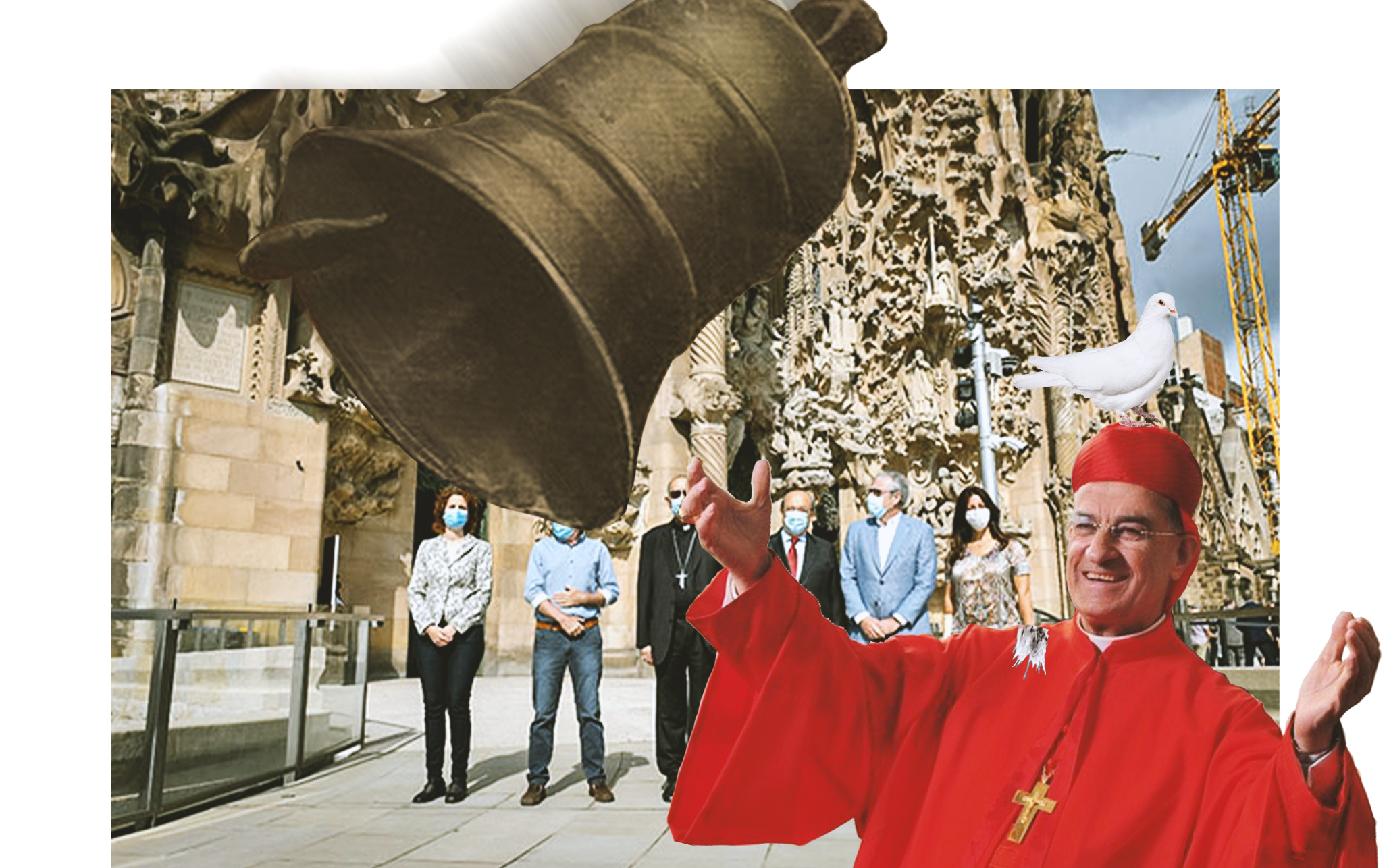
ACT-4:
CARDINAL: W..Whh..What just happened?
JACINT: Nothing, God released the bell from Heaven. Though you might need it.
TOA: Seems like there was a mistake in you computation, Techie! How would you explain it?
TECH: Why? “Whenever a mechanism is equipped with a processor capable of finding a method of finding a method of solution, the authorhship of the answer probably belongs to the machine“22
But now the machine was folllowing the rules you imposed with your design, it’s all your responsability.
(N. Negroponte, Toward a Theory of Architecture Machines. p. 1)
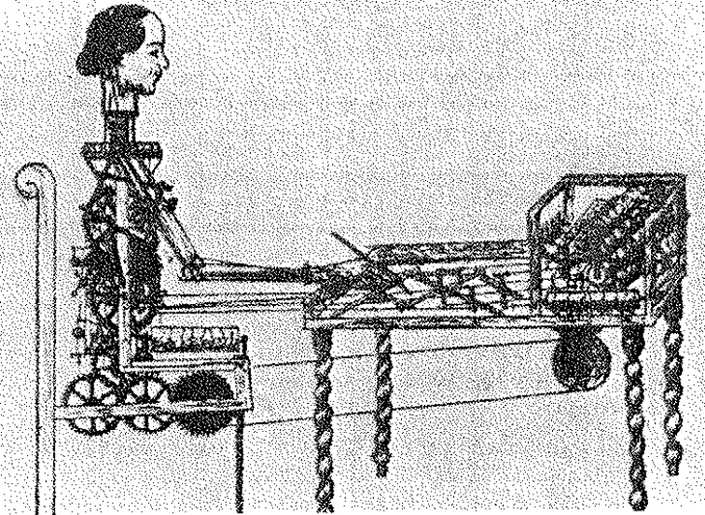
TOA: Our design? We made sure to share with you all the steps and the processes we’ve been undergoing through, you’ve always been update with every new aesthetic details, you had all the means to let the script follows successfully the design
JACINT: Gentlemen, “For all of its almost unlimited versatility, the computer is still a tool—a technical mediator that in this instance is interposed between a designer and an object of design.”23
How could you blindly just trust it.. ah ah ah
(M. Carpo, The alphabet and the algorithm, p. 34)
*the atmosphere becomes more and more tense, the dust raised by the bell still circulates in the air, creating a sort of cloud that hovers and surrounds the members. A figure can be seen coming from afar, piercing the heavy air.
*The Lawer, who came a few minutes before, heard the discussion and step in in the conversation*
LAWYER: Dear All, sorry for the delay. I was supposed to be here only to testify ICOMOS’s announcement but I was not expecting such a situation, I can help out if you Gentlemen allow me to know to who may I refer to?
TECH: You should talk with the ToA here, they made the design!
TOA: Techie, as I already said “an architect’s name is not simply an element of speech”,24 you cannot refer to us as you please. The design could have never reached this level of details without your computational approach,
We are equally responsible for it, Am I not right, Mr Lawer?!
(M. Foucault, What is an author)
LAWYER: Well, on this note I’ll address that both of you are being equally responsible for what just happened, since you are the ones who were in charge of this contemporary intervention.
ICOMOS: Thank you Mr. Lawyer for finally making a point that this new intervention has brought new authors into the frame. Your Eminence, as we just stated, this was not all Gaudì’s will. This final Cathedral has been achived thanks to the personal contribution of every architect and expert who gave his all into its completion.
*Cardinal nods his head quitely, with an empty face*
JACINT: Symbiosis, This is the right term to use to simplify the whole process you just described. This Cathedral’s authorship lies in Symbiosis:
“The author is the one who brings the idea, via the visual and verbal object of the building, to the user, who chooses to bring worlds of imagination to life, or destroy them.”
‘We are the hands and eyes and ears, the sensitive probing feelers through which the emergent, intelligent universe comes to know its own form and purpose. We bring the thunderbolt of meaning and significance to unconscious matter, blank paper empty spaces, the night sky. We are already divine magicians, already supergods. Author and reader together. Put down the book. Begin reading again.25
(Greene D., Who is that knocking on your door, p. 169)
CURTAIN.
Bibliography:
Adjaye D., Hirsch N., Otero-Pailos J., On Architecture and Authorship, Places Journal, 2011
Alberti L. B., De re aedificatoria (On the art of building, 1452), in Rykwert, J., R. Tavernor & N. Leach (Trans. and Eds.), On the art of building in ten books. Cambridge, MA and London: MIT Press, 1988
Barthes R., The death of the author, London, 1977
Carpo M., The Alphabet and the algorithm, The MIT Press, Cambridge, 2011
Carpo M., Digital Indeterminism: The new digital commons and the dissolution of architectural Authorship, 2013
Cline E., The Lasting Relationship between Antonio Gaudí and Barcelona, Spain, 2011
Cockburn J., Gaudí and the Establishment of Catalan Cultural Identity, Birkbeck College, 2004
Compagno D., Theories of Authorship and Intention in the Twentieth Century: An Overview, Journal of Early Modern Studies, 2012
Foucalt M., What is an author?, 1969
Greene D., ‘Who Is That Knocking on Your Door?’: Authorship, Print, and the Multimodal Comics of Grant Morrison in the Digital Age’ in The Birth and Death of the Author: A Multi-Authored History of Authorship in Print, 2020
Homar C., Serralonga A., The Sagrada Família, a pioneer in applying manufacturing robots to architectures, 2019
Le Corbusier, Towards a new Architecture, Dover Publications, New York, 1986
Negroponte N., Toward a Theory of Architecture Machines, Association of Collegiate Schools of Architecture, Vol.23, No. 2 (Ma. 1969)
Manovich L., AI Aesthetics, Strelka Press, Moscow, 2019
Margulis L., The Symbiotic Planet, Phoenix, London, 2001
Martínez de Guereñu L., Who Designs Architecture? On Silenced and Superimposed Authorship, Revista de Arquitectura 23, 2021
Ratti C., Claudel M., Open Source Architecture, Thames & Hudson, 2014
Sanchez J., Architecture for the Commons, Routkedge, 2021
Tonissen R., The Death of the Architect, Wageningen University, 2013

